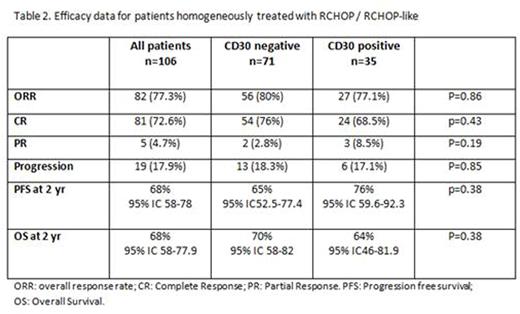Abstract
Background: DLBCL is a heterogeneous disease with 30% of patients presenting as refractory/relapsing disease following R-CHOP treatment. Therefore, new prognostic factors to identify the poor-risk population and alternative therapies for them are needed. CD30 is a member of the tumour necrosis factor receptor (TNFR) super family and is expressed by several types of T- and B-cell non-Hodgkin lymphomas. Brentuximab vedotin, an anti CD30 antibody, is used in clinical practice for Hodgkin lymphoma and systemic anaplastic large cell lymphoma. The significance of CD30 expression in DLBCL remains unknown. We aimed to study the expression of CD30 in a large cohort of the novo DLBCL patients homogeneously treated with R-CHOP or R-CHOP-like protocols to evaluate its correlation with clinical and biological characteristics at diagnosis and its impact in clinical outcome.
Methods: we prospectively registered 155 patients diagnosed of DLBCL between January 2012 to December 2015 in our center. Twenty-one patients with primary central nervous system DLBCL, transformed lymphoma or post-transplant DLBCL were excluded from the study. Anatomopathology review was performed in all cases, and 14 cases with not enough histological tissue to perform additional staining were also excluded. Immunohistochemistry was performed in 120 cases on 4 microns' paraffin sections using routine protocols,CD30 expression was analyzed using the antibodyCD30 clone BerH2, dilution 1:30; Dako; staining in more than 10% of the malignant cells was considered positive. Samples were classified as germinal center B-cell-like (GCB) vs. non-GCB subtypes by immunohistochemistry according to Hans algorithm. Univariate analyses were assessed by Chi square test. Survival curves were estimated using the Kaplan-Meier method and compared using the log-rank test. Multivariate analyses for progression-free survival (PFS) were assessed Cox proportional hazard regression model.
Results: among the 120 cases analyzed, CD30 was expressed in 40 (33.3%). Clinical and biological characteristics at disease presentation are shown in Table 1. The expression of CD30 was significantly higher in the non-GCB subtype cases (p=0.0001). One hundred and six patients were homogeneously treated with R-CHOP (100 patients) or R-CHOP-like (1 R-COMP, 2 Burkitt scheme, 1 GA101-CHOP and 2 R-Bortezomib-CAP), and were included in the outcome analyses. Response rates and survival of this subgroup of patients are shown in Table 2. With a median follow-up of 16.4 months, no differences were found neither in PFS or OS between CD30 positive and CD30 negative patients (Table 2). In the multivariate analyses including the following independent variables: gender, B-symptoms, Bulky mass (>5cm), cell of origin (GCB vs non-GCB), International Prognostic Index (IPI) and CD30 expression, IPI 3-5 was de only factor significantly related with poor PFS (HR 2.92, 95% CI:1.18-7.24, p=0.02).
Conclusion: CD30 is expressed in one third of DLBCL patients, in whom an anti-CD30 therapy could be used. CD30 expression is significantly higher in patients with non-CGB DLBCL, however and in our experience, its expression does not influence either response to R-CHOP or R-CHOP- like therapy or survival.
Gonzalez Barca:Gilead: Speakers Bureau; Janssen: Membership on an entity's Board of Directors or advisory committees, Speakers Bureau; Roche: Speakers Bureau.
Author notes
Asterisk with author names denotes non-ASH members.



This feature is available to Subscribers Only
Sign In or Create an Account Close Modal